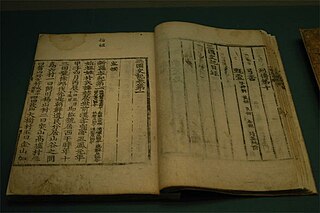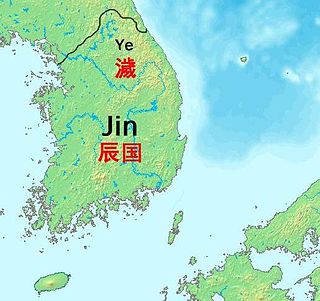
Classical Chinese, also known as Literary Chinese, is the language of the classic literature from the end of the Spring and Autumn period through to the end of the Han dynasty, a written form of Old Chinese. Classical Chinese is a traditional style of written Chinese that evolved from the classical language, making it different from any modern spoken form of Chinese. Literary Chinese was used for almost all formal writing in China until the early 20th century, and also, during various periods, in Japan, Korea and Vietnam. Among Chinese speakers, Literary Chinese has been largely replaced by written vernacular Chinese, a style of writing that is similar to modern spoken Mandarin Chinese, while speakers of non-Chinese languages have largely abandoned Literary Chinese in favor of their respective local vernaculars. Although languages have evolved in unique, different directions from the base of Literary Chinese, many cognates can be still found between these languages that have historically written in Classical Chinese.
There are various names of Korea in use today, all derived from ancient kingdoms and dynasties. The modern English name "Korea" is an exonym derived from the name Goryeo, also spelled Koryŏ, and is used by both North Korea and South Korea in international contexts. In the Korean language, the two Koreas use different terms to refer to the nominally unified nation: Chosŏn in North Korea and Hanguk in South Korea. Ethnic Koreans living in China and Japan also use the term Chosŏn to refer to Korea.

Samguk sagi is a historical record of the Three Kingdoms of Korea: Goguryeo, Baekje and Silla. The Samguk sagi is written in Classical Chinese, the written language of the literati of ancient Korea, and its compilation was ordered by King Injong of Goryeo and undertaken by the government official and historian Kim Busik (金富軾) and a team of junior scholars. Completed in 1145, it is well known in Korea as the oldest surviving chronicle of Korean history.

The Three Kingdoms of Korea refers to the three kingdoms of Goguryeo, Baekje, and Silla. Goguryeo was later known as Goryeo, from which the modern name Korea is derived. The Three Kingdoms period is defined as being from 57 BC to 668 AD.

Silla or Shilla was a Korean kingdom located on the southern and central parts of the Korean Peninsula. Silla, along with Baekje and Goguryeo, formed the Three Kingdoms of Korea.

Samguk yusa or Memorabilia of the Three Kingdoms is a collection of legends, folktales and historical accounts relating to the Three Kingdoms of Korea, as well as to other periods and states before, during and after the Three Kingdoms period. It is the earliest extant record of the Dangun legend, which records the founding of Gojoseon as the first Korean nation. The Samguk yusa is National Treasure No. 306.

Kim Yu-shin was a general in 7th-century Silla. He led the unification of the Korean Peninsula by Silla under the reign of King Muyeol and King Munmu. He is said to have been the great-grandchild of King Guhae of Geumgwan Gaya, the last ruler of the Geumgwan Gaya state. This would have given him a very high position in the Silla bone rank system, which governed the political and military status that a person could attain.

Spoken and written Vietnamese today uses the Latin-script based Vietnamese alphabet, the lexicon altogether containing native Vietnamese words derived from the Latin script, Chinese-Vietnamese words (Hán-Việt), Nôm words, and other adapted foreign words. Historic Vietnamese literature was written by scholars in Nôm and before that Hán.

The Records of the Three Kingdoms is a Chinese historical text which covers the history of the late Eastern Han dynasty and the Three Kingdoms period. It is widely regarded as the official and authoritative source historical text for that period. Written by Chen Shou in the third century, the work synthesizes the histories of the rival states of Cao Wei, Shu Han and Eastern Wu in the Three Kingdoms period into a single compiled text.

Mahan was a loose confederacy of statelets that existed from around the 1st century BC to 5th century AD in the southern Korean peninsula in the Chungcheong and Jeolla provinces. Arising out of the confluence of Gojoseon migration and the Jin state federation, Mahan was one of the Samhan, along with Byeonhan and Jinhan. Baekje began as a member statelet, but later overtook all of Mahan and became one of the Three Kingdoms of Korea.
Jinhan was a loose confederacy of chiefdoms that existed from around the 1st century BC to the 4th century AD in the southern Korean Peninsula, to the east of the Nakdong River valley, Gyeongsang Province. Jinhan was one of the Samhan, along with Byeonhan and Mahan. Apparently descending from the Jin state of southern Korea, Jinhan was absorbed by the later Silla, one of the Three Kingdoms of Korea.

The state of Jin was a confederacy of statelets which occupied some portion of the southern Korean peninsula during the 2nd and 3rd centuries BCE, bordering the Korean kingdom Gojoseon to the north. Its capital was somewhere south of the Han River. It preceded the Samhan confederacies, each of which claimed to be successors of the Jin state.

Samhan, or Three Han, is the collective name of the Byeonhan, Jinhan, and Mahan confederacies that emerged in the first century BC during the Proto–Three Kingdoms of Korea, or Samhan, period. Located in the central and southern regions of the Korean Peninsula, the Samhan confederacies eventually merged and developed into the Baekje, Gaya, and Silla kingdoms. The name "Samhan" also refers to the Three Kingdoms of Korea.

Korean poetry is poetry performed or written in the Korean language or by Korean people. Traditional Korean poetry is often sung in performance. Until the 20th century, much of Korean poetry was written in Hanja and later Hangul.

Korean literature is the body of literature produced by Koreans, mostly in the Korean language and sometimes in Classical Chinese. For much of Korea's 1,500 years of literary history, it was written in Hanja. It is commonly divided into classical and modern periods, although this distinction is sometimes unclear. Korea is home to the world's first metal and copper type, the world's earliest known printed document and the world's first featural script.

Korean mixed script, known in Korean as hanja honyong, Hanja-seokkeosseugi, 'Chinese character mixed usage,' or gukhanmun honyong, 'national Sino-Korean mixed usage,' is a form of writing the Korean language that uses a mixture of the Korean alphabet or hangul and hanja, the Korean name for Chinese characters. The distribution on how to write words usually follows that all native Korean words, including grammatical endings, particles and honorific markers are generally written in hangul and never in hanja. Sino-Korean vocabulary or hanja-eo, either words borrowed from Chinese or created from Sino-Korean roots, were generally always written in hanja although very rare or complex characters were often substituted with hangul. Although the Korean alphabet was introduced and taught to people beginning in 1446, most literature until the early twentieth century was written in literary Chinese known as hanmun.
The traditional periodization of Korean distinguishes:
Yemaek or Yamaek were an ancient tribal group in the northern Korean Peninsula and Manchuria who are regarded by many scholars as the ancestors of modern Koreans. They had ancestral ties to various Korean kingdoms including Gojoseon, Buyeo, Goguryeo, and tribes including Okjeo, Dongye(Ye), Yangmaek and Sosumaek.

Gaya, also rendered Kaya, Kara or Karak, is the presumed language of the Gaya confederacy in southern Korea. Only one word survives that is directly identified as being from the language of Gaya. Other evidence consists of place names, whose interpretation is uncertain.

Chinese writing, culture and institutions were imported as a whole by Vietnam, Korea, Japan and other neighbouring states over an extended period. Chinese Buddhism spread over East Asia between the 2nd and 5th centuries AD, followed by Confucianism as these countries developed strong central governments modelled on Chinese institutions. In Vietnam and Korea, and for a shorter time in Japan and the Ryukyus, scholar-officials were selected using examinations on the Confucian classics modelled on the Chinese civil service examinations. Shared familiarity with the Chinese classics and Confucian values provided a common framework for intellectuals and ruling elites across the region. All of this was based on the use of Literary Chinese, which became the medium of scholarship and government across the region. Although each of these countries developed vernacular writing systems and used them for popular literature, they continued to use Chinese for all formal writing until it was swept away by rising nationalism around the end of the 19th century.














